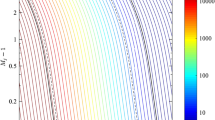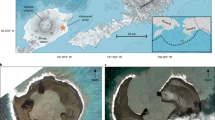Abstract
A WIDE variety of methods has been used in the estimation of the static tensile strength of water1,2. Recently, a dynamic method, using an impulse-generated pressure wave, has been described which uses a measurement of the negative pressure produced by the wave reflected from a free surface3. Wilson et al.4 had previously shown how estimates of the negative-pressure wave reflecting from a free surface could be used to measure liquid tensile strength in underwater-explosion research, and an adaption of that technique has been used to estimate the tensile strength of water and glycerine. The basic idea is to make high speed motion picture photographs of the spray plume rising from an explosive charge detonated a small distance underwater. In a one-dimensional analysis the particle velocity of the explosive shock wave propagates as P/ρU, and hence water at the free surface detaches with an initial velocity 2P/ρU, less the contribution of the tension exerted by the reflected shock wave T/ρU. So the initial spray dome velocity is:  where P is the maximum pressure of the explosion, T is the negative pressure in the reflected shock wave, ρ is the water density, and U is the shock wave velocity. By observing the value of V0 at various explosive charge depths and extrapolating to zero velocity where T = 2P, an estimate of the water tensile strength can be made.
where P is the maximum pressure of the explosion, T is the negative pressure in the reflected shock wave, ρ is the water density, and U is the shock wave velocity. By observing the value of V0 at various explosive charge depths and extrapolating to zero velocity where T = 2P, an estimate of the water tensile strength can be made.
This is a preview of subscription content, access via your institution
Access options
Subscribe to this journal
Receive 51 print issues and online access
$199.00 per year
only $3.90 per issue
Buy this article
- Purchase on Springer Link
- Instant access to full article PDF
Prices may be subject to local taxes which are calculated during checkout
Similar content being viewed by others
References
Hayward, A. T. J., Am. Scient., 59, 434 (1971).
Apfel, R. E., Sci. Am., 227, 58 (1972).
Couzens, D. C. F., and Trevena, D. H., Nature, 222, 473 (1969).
Wilson, D. A., Cotter, B. A., and Price, R. S. in Underwater Explosion Research II, (edit. by Hartmann, G. K., and Hill, E. G.), 637 (Office Of Naval Reserch, 1950).
Cole, R. H., Underwater Explosions (Dover, New York, 1965).
Author information
Authors and Affiliations
Rights and permissions
About this article
Cite this article
WILSON, D., HOYT, J. & MCKUNE, J. Measurement of tensile strength of liquids by an explosion technique. Nature 253, 723–725 (1975). https://doi.org/10.1038/253723a0
Received:
Published:
Issue Date:
DOI: https://doi.org/10.1038/253723a0
This article is cited by
-
Mechanics of xylem sap drinking
Biomedical Engineering Letters (2013)
-
Nonlinear problems of cavitation breakdown of liquids under explosive loading (review)
Journal of Applied Mechanics and Technical Physics (1993)
Comments
By submitting a comment you agree to abide by our Terms and Community Guidelines. If you find something abusive or that does not comply with our terms or guidelines please flag it as inappropriate.



